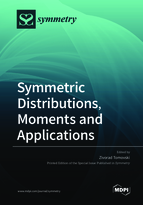Symmetric Distributions, Moments and Applications
A special issue of Symmetry (ISSN 2073-8994). This special issue belongs to the section "Mathematics".
Deadline for manuscript submissions: closed (30 June 2022) | Viewed by 14374
Special Issue Editor
Interests: analysis; probability theory and stochastic processes; pde; integral equations; approximation theory; analytical inequalities; dynamical systems and ergodic theory; fractional calculus and special functions; statistical mechanics
Special Issue Information
Dear Colleagues,
This Special Issue on distributions and moments (DaM) will publish papers on the theory and applications of probability and statistics. Papers including original results of symmetric random walks and their characterization, stochastic processes, stochastic integrals, martingales, probability inequalities, statistics parameter estimation, stochastic differential equations, fractional Brownian motions, continuous time random walk models, anomalous diffusion models, Black–Scholes models, Monte Carlo methods, etc. are welcome. Also welcome are papers on complex dynamical systems, population dynamics modeling, finance mathematics, physical sciences, and any field where stochastic modeling is used. This Special Issue will focus on concepts and techniques and be oriented toward a broad spectrum of applied mathematics and sciences. Focused review articles that review the state of the art and identify upcoming challenges and promising solutions for the scientific community are also invited.
Dr. Zivorad Tomovski
Guest Editor
Manuscript Submission Information
Manuscripts should be submitted online at www.mdpi.com by registering and logging in to this website. Once you are registered, click here to go to the submission form. Manuscripts can be submitted until the deadline. All submissions that pass pre-check are peer-reviewed. Accepted papers will be published continuously in the journal (as soon as accepted) and will be listed together on the special issue website. Research articles, review articles as well as short communications are invited. For planned papers, a title and short abstract (about 100 words) can be sent to the Editorial Office for announcement on this website.
Submitted manuscripts should not have been published previously, nor be under consideration for publication elsewhere (except conference proceedings papers). All manuscripts are thoroughly refereed through a single-blind peer-review process. A guide for authors and other relevant information for submission of manuscripts is available on the Instructions for Authors page. Symmetry is an international peer-reviewed open access monthly journal published by MDPI.
Please visit the Instructions for Authors page before submitting a manuscript. The Article Processing Charge (APC) for publication in this open access journal is 2400 CHF (Swiss Francs). Submitted papers should be well formatted and use good English. Authors may use MDPI's English editing service prior to publication or during author revisions.
Keywords
- stochastic processes
- moments
- symmetric distributions
- finance models
- stochastic differential equation
- parameter estimation






